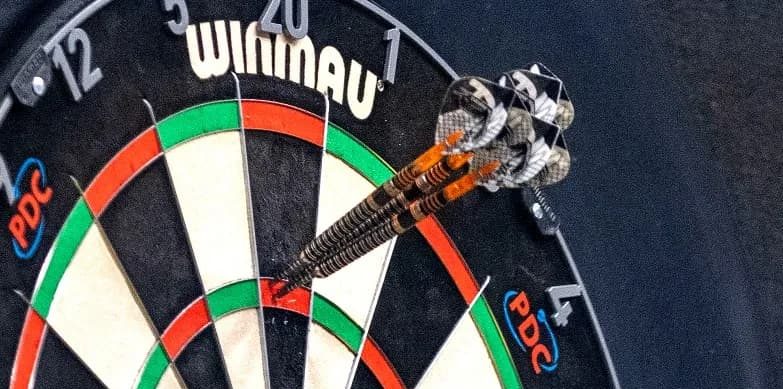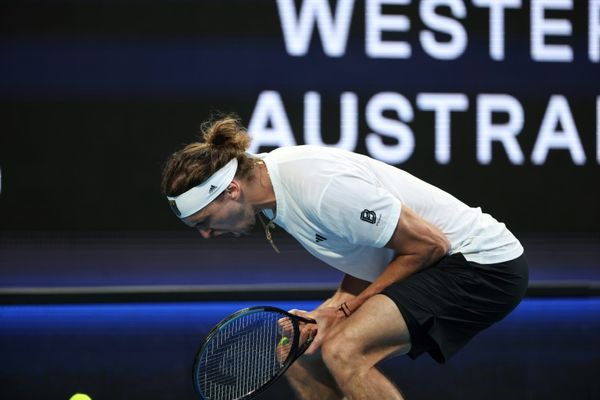
Have you ever wondered why dartboards are coloured with red, green, white and black? Join us as we investigate exactly why dartboards use these four colours and what each of them represents in the sport of darts.
What Do The Colours On A Dartboard Mean?
As a sport, darts has increased in popularity massively over the years. Now, it has reached new heights, predominantly thanks to teenage sensation Luke Littler. More eyeballs than ever are on the sport, which in turn means more questions from fans about certain things.
For example, fans are now questioning some of the rules of darts, such as why does a leg begin at 501? Another question fans are asking is about the perfect nine-dart finish, and even the showpiece outshot – the 170 checkout or ‘Big Fish’.
Another thing darts fans are now asking is what the different colours on a dart board mean. In total, there are four colours on a dart board. These are of course black, white, red and green.
The black and white segments indicate the single-number sections from 1-20, meanwhile the green and red segments are assorted double and treble sections, as well as the outer bull (green) and bullseye (red).
These four shades on the dartboard indicate different things and help players distinguish between the different scoring zones. But why exactly these colours?
Why Are Dartboards Coloured Red & Green?
As previously explained, there are actually some facts and justified reasoning behind the colours of a dartboard. The bullseye is red, the outer-bull (25 segment) is green, with the rest of the double and treble segments a mixture of red and green too in alternate fashion.
The reasoning behind the red and green colouring on a dartboard is very simply. It dates back years and years, with the colours chosen to symbolise parts of British culture and history.
The striking red shade is associated with the Tudor rose, whilst the green segments are associated with the House of Lancaster. The dartboard colour scheme in fact dates back to the ‘War of the Roses’, hence why green and red are used on the dartboard.
According to DartsConnect: “The red and green colours are found in the double and triple rings, as well as the inner and outer bullseye. These vibrant hues draw attention to these higher-scoring areas and provide a clear visual distinction from the black and white segments.
“It is believed that the red and green colours on the dartboard were chosen as a nod to British history and culture. Red is associated with the Tudor rose, the heraldic emblem of England, while green is linked to the House of Lancaster, one of the major factions in the Wars of the Roses. By incorporating these colours into the design, dartboard manufacturers created a symbolically rich and visually striking gamepiece.”
Why Is A Dartboard Predominantly Black & White?
Darts becomes one of the most popular sports in the UK around Christmas and New Year time. This is of course because of the World Darts Championship at Ally Pally.
The likes of Michael van Gerwen, Luke Littler, Luke Humphries, Michael Smith and Gerwyn Price battle it out for the coveted Sid Waddell Trophy each and every year, with fans tuning in in their millions to find out who will be crowned champion of the world.
As previously explained, having more eyes on the sport means more questions surrounding the rules. We have outlined why red and green colours are used, but what about the rest of the board?
The rest of the dart board is black and white, alternating one after each other going around in a circle. Both black and white indicate the single-number sections from 1-20.
The reason why they are coloured black and white is up for debate, but the origins of the dartboard’s colour scheme can be traced back to its early design. Dartboards were originally made from the end grain of a tree trunk, with the natural growth rings inspiring the segmented design.
Colour was added as the game evolved to make the board more visually appealing, as well as to help enhance a player’s experience. According to DartsConnect, this is why the black, white, red and green colour scheme is used:
“The alternating black and white segments divide the board into 20 equal scoring sections, numbered 1 to 20. These contrasting colours make it easier for players to distinguish between the different scoring zones and improve overall visibility during gameplay.”
Be sure to claim the various darts betting offers and free bet deals available on the SportsCasting site ahead of the biggest and best darts tournament worldwide.







